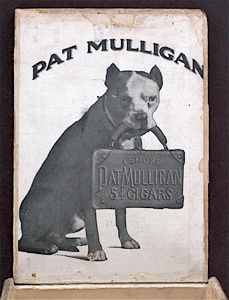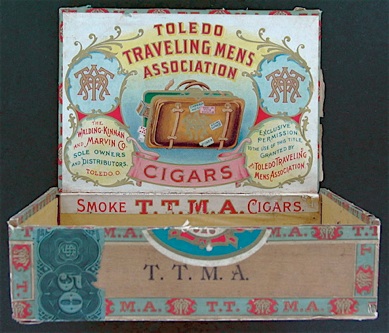Cigar Salesmen as seen on Boxes
How the industry viewed its own
A National Cigar Museum Exhibit
© Tony Hyman

Cigar Salesmen as seen on Boxes
How the industry viewed its own
A National Cigar Museum Exhibit
© Tony Hyman
Between the Civil War and World War One (1865-1916), more than a million retailers had a cigar counter offering the three-quarters of American men who smoked cigars a selection gleaned from the six billion cigars made each year. Most of those cigars got into those counters because of a salesman. Salesmen blanketed America moving not only cigars but all the nation’s other consumer goods as well. Salesmen were an integral part of our country, and thus became part of its pop culture as well. Traveling salesmen became the subject of stories, anecdotes and vaudeville routines. Entire books of salesmen jokes were available, though the jokes told in the barber shops and pool halls rarely made it into print.
Advertisers, commercial artists, label printers and retailers, all played on contem-porary pop cultural facts, foibles, fashions and fantasies. Remind you of today? This was today, more than a century ago. Throughout the Museum, you’ll find exhibits, ultimately around 60 of them, devoted to various advertising themes. This exhibit looks at how the industry saw itself.
Salesmen have always been a favorite topic of mine because of their importance in the creation of so many brands and packaging modes. They really would promise anything to make the sale. There’s more on salesmen elsewhere in the Museum.
And if junior can’t cut it on the road send the dog. The question is what is the dog holding? Looks like a small fiberboard salesman’s sample case about the size of a standard 50/13 cigar box. Fiber cases could be customized, but embossing them requires a die, which adds cost, suggesting a goodly number of cases were made to offset the set-up cost. This sales-man’s sample box is from 1913.
Cigars were made in Fact. 852, 1st PA owned by Boltz, Clymer & Co., Perkasie, PA.
[0553]

And if dad can’t make a living, put junior on the road. Was there really a little kid who, all dressed up, accompanied dad on the road?
It’s certainly possible, but it’s more likely this 1927 box uses a gag photo for the newly introduced small 5¢ version of a 10¢ cigar.
Fact. 371 in Minnesota was the Litchfield Cigar Factory run by Thomas Wandok.
[0557]
In the cigar world’s early machine age after World War One, salesmen were still regarded as “pushy.” Some took it as a compliment. This 1928 box was used by Fact 351, 6th Indiana.
[0555]
The most frequently seen portrayal of a salesman on a cigar box is HUSTLER, fount only on a NW 12/6 “sample” size that was probably sold retail in the first decade of 1900.
Collectors have found a couple dozen of these, a lot of boxes for an unadvertised turn-of-the century brand of cigars made by J.W. Gohn Cigar Co., East Prospect, PA. Miller was probably the wholesaler.
[0552]
At first glance, the combination of “Representative” and the elephant appears to some to be a political box, but the jumbo smoking a jumbo is a salesman representing The Elephant Cigar Company from Detroit.
Fact. 504, 1st Michigan 1898
[0554]
Glad to be done at day’s end, an 1884 salesman is pictured with booze, women, cards, pets and slippers, the fantasy of an artist who hadn’t spent time on the road.
The brand names were a satire on the proliferation of private labels in the 1870’s and 80’s.
MY SISTER, MY BROTHER, MY AUNT, MY UNCLE, MY NEPHEW and MY NEICE. Fact. 253, 3rd tax District (Lower Manhattan), NYC.
[0550]
Salesmen by their very nature are optimists. The FIRST TRIP depicts a salesmen day dreaming of orders as he sets out on his maiden train voyage.
If he called on retailers, orders of 500 were more typical than the tens of thousands in his dreams. Orders of 25,000 to 100,000 cigars at a time were to be had from big wholesalers, however.
[0506]
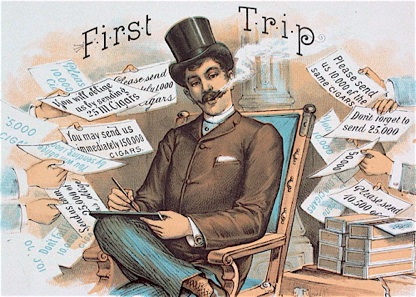
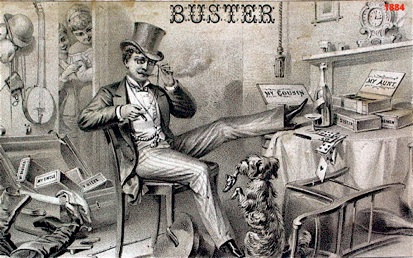

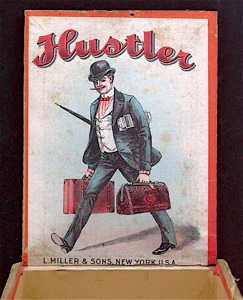
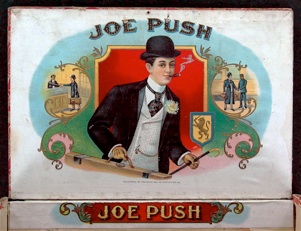

Salesmen formed organizations to help with insurance, information and other benefits. Think of them as pre-automobile traveling man’s A.A.A. Naturally, someone used the name as a cigar brand.
Did this brand actually have any association with the Association? ¿Quien sabe? American Cigar Company made these in their Poughkeepsie Fact. 331, 14th NY around 1902.
[0551]
